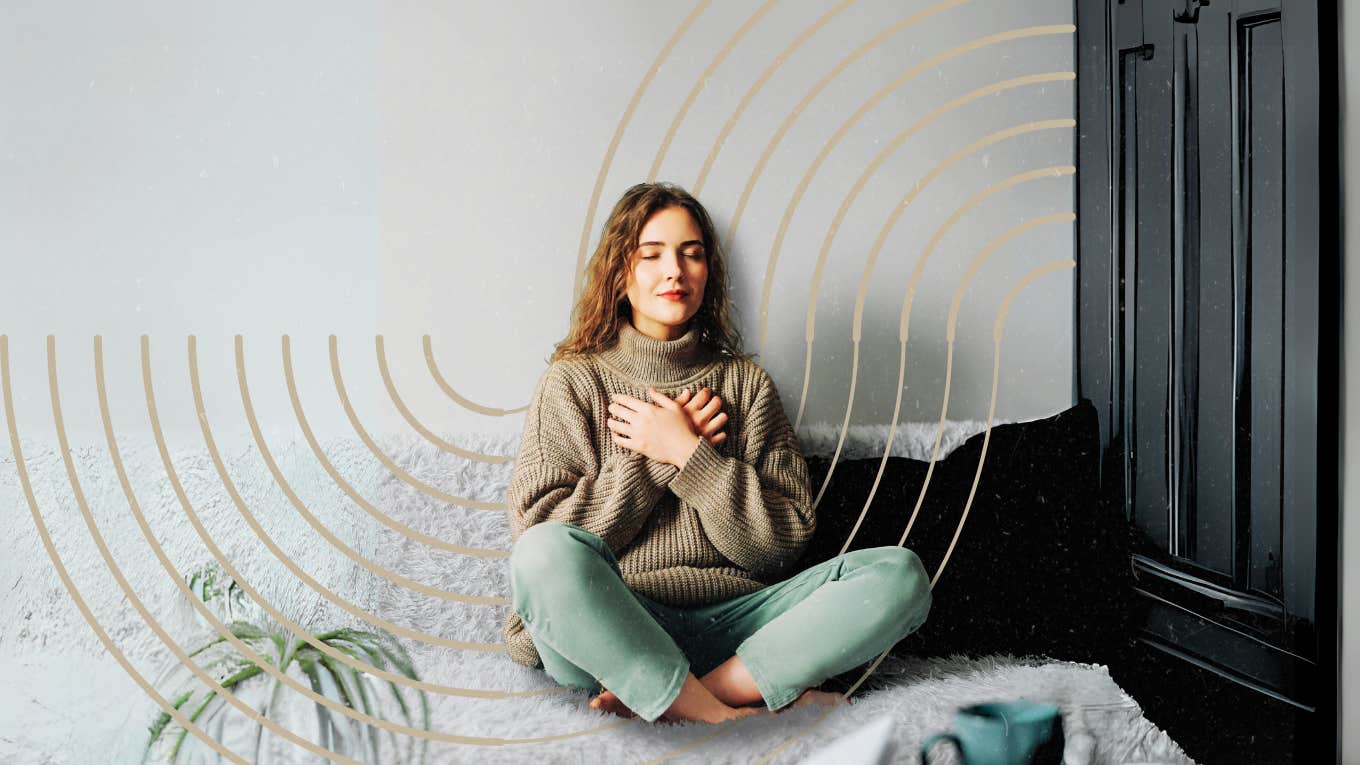The 3-Minute Breath-Based Ritual That Calms Even The Worst Anxiety
For the moments when "just breathe" only makes you feel worse.
 Yauhen Akulich | Canva
Yauhen Akulich | Canva Chances are you've been told to "Just breathe," a million times. But like, how? When someone’s in the midst of a panic attack or feeling anxious, breathing is probably the last thing on their mind. Am I right?
Luckily, there are breathing exercises for anxiety that can help you feel calm when your stress levels go through the roof. This is a simple, effective breathing exercise you can do anywhere, anytime.
The best breathing exercise for anxiety: Halo-Active Breath
This breathing exercise is a game-changer. Halo-Active Breath is a breathing exercise for anxiety that combines nose and mouth breathing. It's super simple to do. All you need is a comfortable place to sit or lie down and about three minutes of uninterrupted time. Here's how it works:
- Take a deep breath in through your nose, allowing your belly to expand
- Exhale out of your mouth, making an optional "ahh" sound
- Repeat this breathing pattern for a minimum of three minutes (I like to do it for at least five)
- After 3 minutes are up, exhale all the air from your lungs and hold your breath - this is called a "bottom hold."
- When you feel ready, return to your regular breathing pattern
What's going on when you feel anxious
When you feel anxious, your breathing becomes quick, rapid, and uncontrolled. This happens automatically and feels like the body is breathing you (versus you breathing the body). This type of breathing is known as "chest breathing," and it's the opposite of what we want to be doing when we're trying to calm down. This is a "fear-based" pattern.
Breathe from your belly
Instead, we want to take deep breaths into the belly. Also known as "diaphragmatic breathing" or "abdominal breathing," this type of breathing activates the parasympathetic nervous system (a.k.a. the "rest and digest" response) and is called a "love-based" pattern at Pause Breathwork. When breathing in this way, your breath becomes slow, fluid, and relaxed.
 Rido via Shutterstock
Rido via Shutterstock
When we talk about the subject of anxiety, the brain often goes to the "fix it" mode. What do I need to do? What supplement do I need to take? What crystal do I need to lick? One of the most powerful ways we can mitigate, release, and clear Rido is through three things.
Three ways to mitigate anxiety, in addition to a great breathing practice
1. Make a list of anything that’s out of alignment
Often, what drains us, depletes our energy, and gives us higher states of anxiety is the emotional misalignment in our lives. So the first thing I do is make myself a list.
What am I saying yes to that is a really a no for me?
Whether that is a work commitment, a relationship, social plans, or a trip coming up, whatever it is. What do you do that is not a full-bodied “YES”? Start by making a list of those things and asking yourself, am I prepared to release this? What would it look like if I let this go?
2. Set boundaries
Anxiety shows me where I need stronger boundaries. A few months ago, I realized my work schedule was getting intense. I was doing 5 hours of meetings a day on top of another 5-7 hours of everything else I needed to do.
Then I was like, wow, I'm burning out. I'm looking at my schedule for the next day, and it's already giving me anxiety. I knew I needed to make a radical change. So I sat down with my assistant and was said, "no matter what, do not let me exceed three hours of meetings a day. Let's keep that boundary."
Since doing that and having a strong boundary around it, it has alleviated so much stress. I realized if I was not honoring a boundary I created, of course, no one else was going to adhere to it either.
 Studio Grand Web via Shutterstock
Studio Grand Web via Shutterstock
It all added up. I couldn't do the things that were important to me. What's critical is at the end of the day, I have enough time, energy, and resources to be super present with my partner, my friends, and my family. I never want to say, "I'm too tired for family and friends because work took precedence today."
I'd never want that because my values are family comes before work. When my values don't add up to my blueprints or reality of what's happening, it sucks. When I look at the things giving me anxiety, I first check in with where I need stronger boundaries.
3. Tell the truth
Where am I not 100 percent honest? Where am I saying, "Fine" when I'm not fine or saying everything's cool when it's totally uncool?
Before I do a breathing exercise for anxiety, I go through these questions, and generally, my answers eliminate whatever threads of anxious contraction I'm holding onto. This is how we get into a better relationship with anxiety.
Rather than anxiety being this annoying thing that comes up, it's like, oh, the anxiety shows us where we're out of alignment. The anxiety shows us where we need more truth. Changing the relationship to the anxiety, rather than it being an inconvenient thing I need to breathe my way out of.
If you feel anxious, you don't want to go on a breathwork rampage and try to get rid of it. That's not healthy. We need to meet the anxiety with love first. We need to accept it fully. We need to integrate it into our bodies. Then we can use the breath as a tool to support us in dealing with anxiety. Not to get rid of it. What happens is we temporarily don't feel anxious (while we're getting high off our oxygen supply), but as soon as we stop doing breathwork, the anxiety will come back.
If we want to heal the anxiety, we have to feel it and take action on what it’s telling us. Deep breathing is one of the quickest, most effective ways to calm down when you or your clients are anxious.

